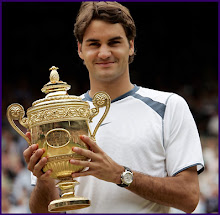WELCOME
Also dont forget to visit my new website WWW.BHARATVERMA.IN
Support Us
Tuesday, March 20, 2007
Tuesday, March 13, 2007
Monday, March 12, 2007
Thursday, March 08, 2007
Saturday, March 03, 2007
Thursday, March 01, 2007
Help with service toss
This one of the question asked to Paul annacone( current coach of Tim henman) and his answer.
Q. I'm just starting to play tennis and my service toss is all over the place. How do I fix it?
A. Simple – practice. You have to be consistent with your ball toss – find the correct area where you like the ball to be when you make contact, then repeat the motion, letting the ball drop to the court without hitting it.
See if it lands in the correct spot on the court and if it achieved the proper height – measure yourself. See how many out of 10 you can do properly, and make it a game each day – watch yourself improve. A smooth, rhythmic motion will help you to get it to repeat.
As a rule of thumb, a right hander should have the ball at “1 o’clock” and a left hander should have the ball at “11 o’clock.” You need to make sure the toss is high enough but those general directions should help.

